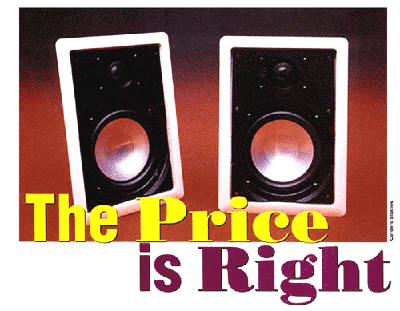This article appeared in the December 1999 issue of
Home Theater Magazine

RBH MC-6 In-wall Speakers
by Jeff Cherun, CFG Labs
The $549/pair MC-6 incorporates aluminum-cone woofers and dome tweeters that produce detailed, uncolored sound.

It seems like we have two choices for in-wall speakers: esoteric, expensive designs that sound good, or inexpensive models you wouldn't want for anything more than background music. What the world needs now is a good $500 in-wall speaker. Although we have stumbled upon a few over achievers in this category— the Boston Acoustics 381 and the Legend Audio Model 4000 come to mind—we've never found one that gave us goosebumps like the best $1,000 pair of in-walls can.
We certainly didn't expect this situation to change when we received the new MC-6 in-wall from RBH Sound. There's nothing visually auspicious about this speaker: just the usual plastic frame, simple crossover, and spring-clip cable connectors. What is unusual about it are its aluminum cone woofers, which aren't a particularly common find in conventional speakers and are all but unknown in the in-wall market. Theoretically, aluminum has major advantages as a woofer-cone material; its excellent stiffness-to-weight ratio is well known to bicycle enthusiasts, airplane designers, and lovers of Coke, Pepsi, Bud, and Coors. In practice, however, aluminum has never particularly excelled as a speaker material. Other materials, like polypropylene and carbon-fiber, have won over many more speaker designers.
In the $549/pair MC-6 , RBH mates its aluminum cone with a 1-inch aluminum-dome tweeter. The tweeter swivels so you can point it at the listener—a common feature with in-walls, and a very useful one if you're mounting the speaker high on a wall. The crossover uses a 6-decibel/octave low-pass filter on the woofer, and a 12-dB/octave high-pass filter on the tweeter.
Easy to Install
After breaking in the speakers with pink noise for 24 hours, we installed them in our custom test walls, which exactly duplicate residential construction in terms of the drywall and studs. Our only tweak to these walls is a layer of insulation behind the speakers, which greatly improves the sound.
The install was easy enough, and the speakers locked in securely. We fed the speakers a stereo signal with a Chiro C-300 amp and the Chiro C-800 preamp/processor, using a Pioneer PDR-04 CD recorder as a source. Before we played a single note, we noticed that the aluminum cone gives this speaker an unusual look--you can see the cone behind the grille. We think it looks cool and high-tech. RBH does provide a thin, white foam insert for those who prefer their in-walls more discreet; this insert gives the speaker a clean, all-white appearance at the cost of perhaps 1 dB of response at 10 kilohertz.
Immediately after playing the first 30 seconds of Ron Sexsmith's song "Words We Never Use," Brent and I fell in love with the MC-6 . The lush soundstage this speaker produces is a delight, rivaling those of the very best in-wall offerings we've heard, such as the PhaseTech CI-100 and the M&K SW-85. The voices sounded surprisingly uncolored; we're just not used to hearing this kind of midrange from in-walls, much less $550/pair in-walls. The highs also sounded great--incredibly detailed yet sweet. I have to say that these are the most detailed-sounding in-wall speakers I've heard yet. As well, on the Jewel track we listened to, the piano really seemed to float between the speakers. Finally! Some in-walls that actually try to image!
The bass the MC-6 exerts is incredible for such a small woofer. On Brent's staple speaker-testing recording, Holly Cole's "Train Song," the bass was full, yet well defined, and it extended much lower than we expected. However, RBH wisely didn't try to do too much with the MC-6 's relatively small woofer--the speaker doesn't play low enough to excite many wall resonances. As a result, the bass doesn't sound boomy and muddy, like most in-walls do.
Of course, as revved up as we were over the MC-6 , we couldn't wait to try the MC-8 , a $599/pair speaker that uses an 8inch aluminum-cone woofer and a slightly different crossover, but is otherwise identical. What we discovered after listening to the same test tracks, however, was that the bigger speaker couldn't perform as well as its little sibling. The bass was out of control, boomy, and indistinct; the upper mids and highs sounded somewhat recessed and hashy. It was hard to believe the two speakers came from the same production line. Why the big difference? Probably because the MC-6 's smaller woofer works much better at high frequencies, so it blends better with the 1-inch tweeter. The MC-8 's bigger woofer probably distorts more at high frequencies, and the 1-inch tweeter can't play low enough to lend a hand. With a relatively shallow high-frequency rolloff on the crossover's low-pass filter, the woofer is still very active well up into the treble range. For in-wall speakers, this woofer's size works to its disadvantage at the bottom end, too; unlike the MC-6 's woofer, this one plays low enough to excite wall resonances that muddy up the bass.

If you are concerned with saving valuable real estate in your pad, and want really good sound while listening to your favorite music, get the MC-6 . These speakers would also sound awesome as a home theater quintet; you'll probably want to add a sub to get more bass, but it's not absolutely mandatory as it is with, say, the M&K SW-85. The MC-6 is little short of a miracle, but get it fast--when professional installers hear how good these are, we'll bet RBH will be back- ordered well into 1998.